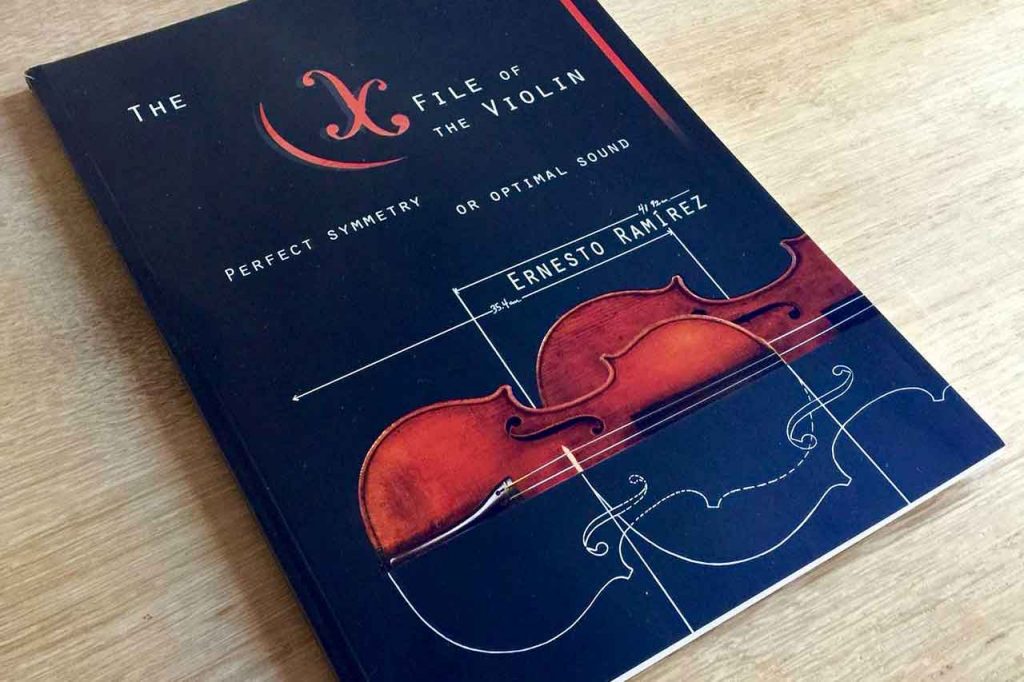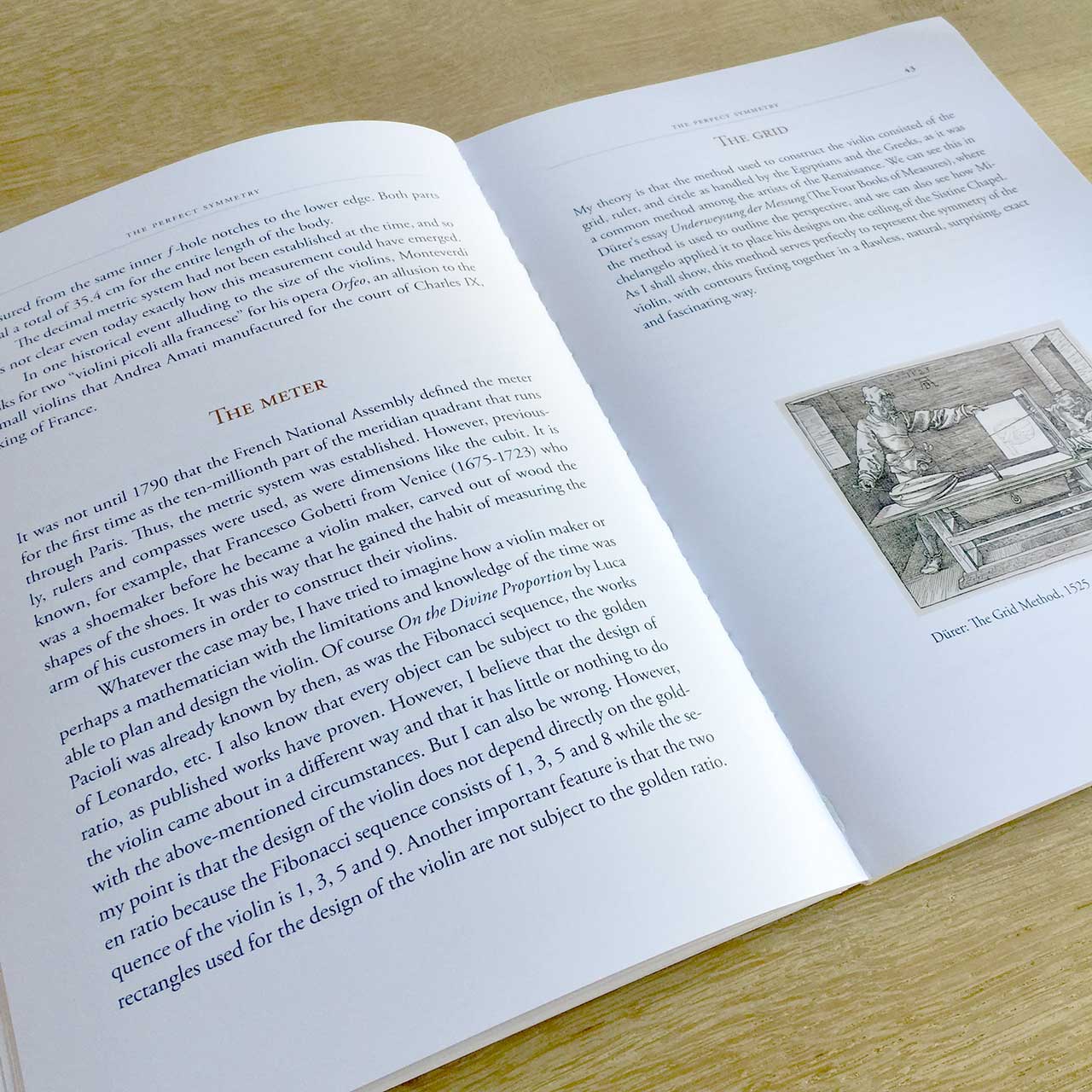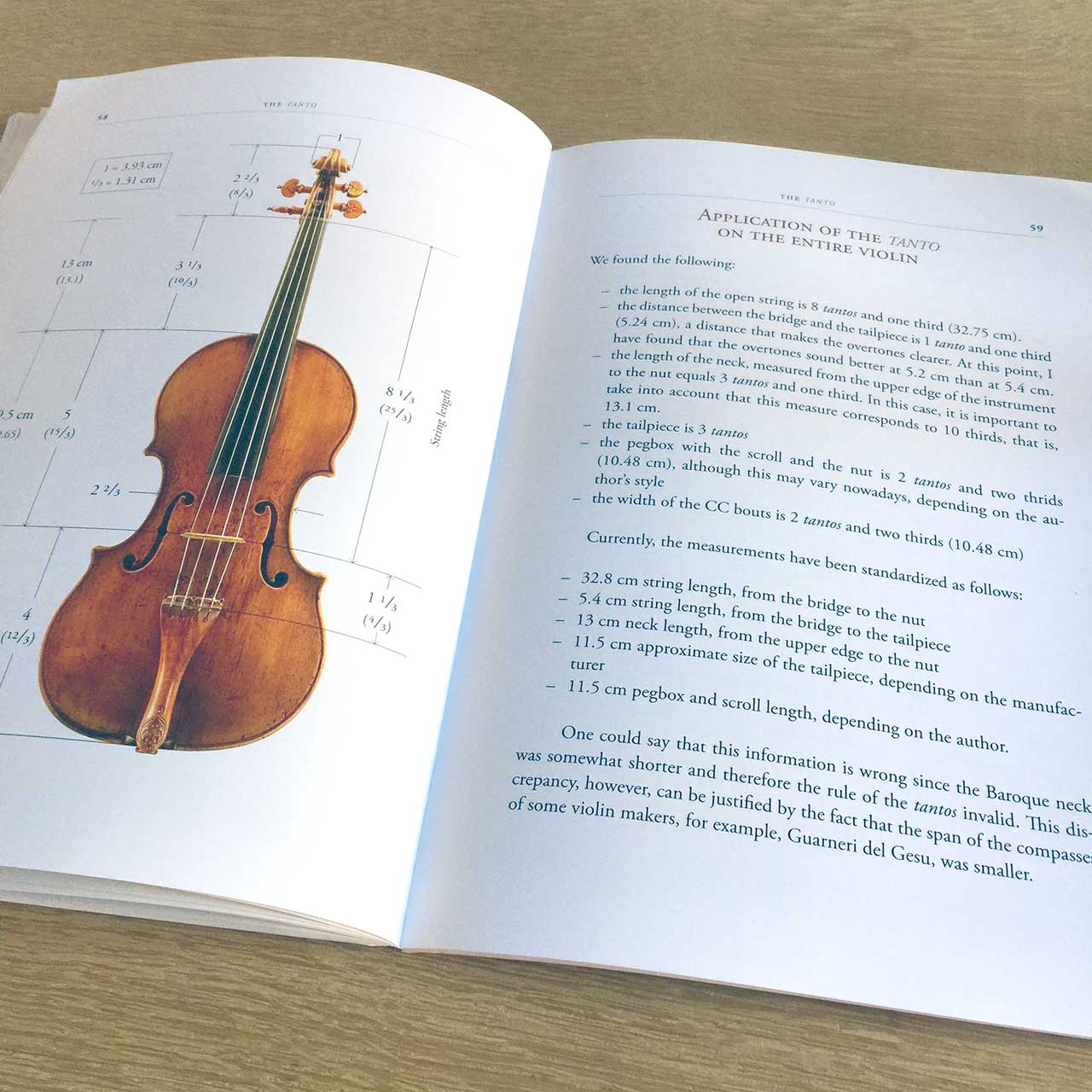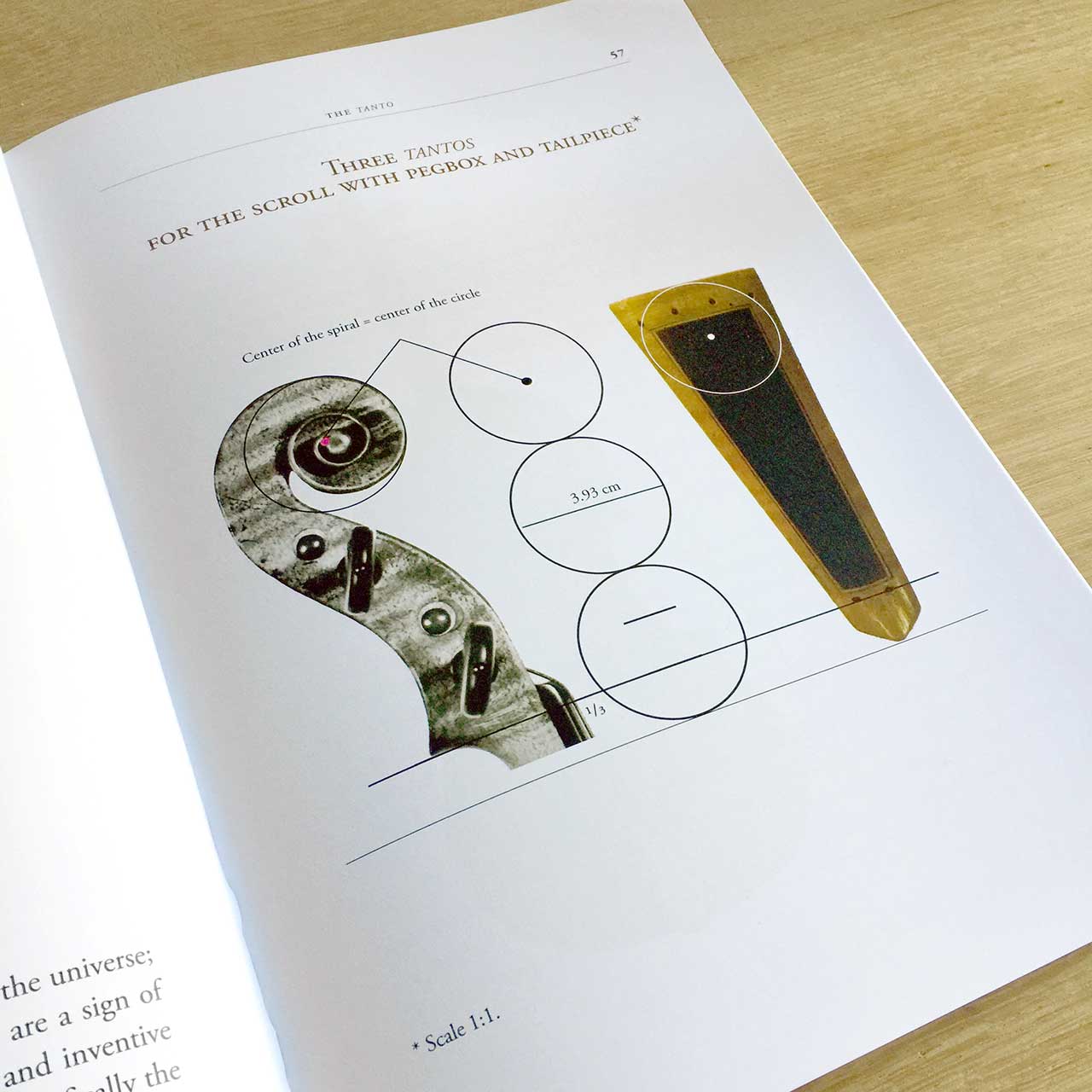
Ernesto Ramirez Luthier Book The X File of the Violin

Ernesto Ramirez Luthier Book The X File of the Violin Perfect symmetry or optimal sound
Ernesto Ramirez Luthier Book The X File of the Violin Perfect symmetry or optimal sound
In practicing my craft as a violin maker for over 40 years, I have worked with dedication and care, in a secluded and quiet manner, and found in this wonderful discipline an ideal refuge for my misanthropy.
The conscious and constant practice of my work has given me some knowledge and many experiences. After my training, initially under the direction of Paul Hart and then under Gabriele Kundert, I began to live with violins. The strength of our relationship has made violins my true teachers. Almost magically, I began a kind of conversation with them; they entrusted me with their secrets and explained some of their mysteries to me.
My main concern in this book is to share some of the most interesting, even fascinating, aspects of the violin with others, including how they originated, the construction methods that were most likely applied, as well as outlines and drawings, created using only a ruler and compass, which are both instruments that appeared around the same time as the violin.
The violin consists essentially of three parts: the shape or the outline, the vacuum or the air contained in the resonance body, and the mass or weight and density of the materials used. The relationship and the perfect balance between these three elements obey exact proportions, leading to an optimal sound. The intention of this study, then, is to present these applied proportions and how they were applied when creating and constructing a violin and, of course, other related instruments.
In order to understand this project better, a few historical facts must be provided. These are accompanied by a few deductive ingredients, the results of my personal research, which underpin the corresponding explanations.
I must point out that this book is neither a manufacturing method for string instruments nor a violin-making manual, but merely the result of my long-time work as a violin maker and my observations on the shape and structure of the violin. The answers I have found concerning violins and the secret of their beauty and perfection justify the pleasure of sharing this information with others.
I hope to be able to pass on this knowledge and I hope it will be useful in some way, not only for violin makers, but also for musicians, and especially for those who are inspired by the violin, the most perfect instrument ever created by human hands. This is my heartfelt endeavor.
Ernesto Ramirez Luthier
Author of the book “The X File of the Violin: Perfect symmetry or optimal sound”

Ernesto Ramirez Autor del libro “El expediente X del violín : La perfecta simetría o el sonido óptimo” (Español)
Durante el ejercicio de mi oficio como laudero por más de 35 años, he trabajado con dedicación y esmero, de una manera apartada y silenciosa, y he encontrado en esta maravillosa disciplina un ideal refugio a mi misantropía.
El ejercicio consciente y constante de mi trabajo me ha dejado algunos conocimientos y muchas experiencias. Después de mi aprendizaje, primero bajo la tutela de Paul Hart y luego de Gabriele Kundert, empecé a convivir con los violines. La fuerza de esta relación hizo que se convirtieran en mis verdaderos maestros. De una manera casi mágica comenzó una especie de diálogo con ellos, confiándome sus secretos y revelándome algunos de sus misterios.
El principal propósito que me ocupa en este escrito es transmitir y compartir algunos aspectos que me parecen de lo más interesante y fascinante acerca del violín, y que corresponden sobre todo a la forma en que fue concebido, el método que probablemente se utilizó y los trazos que se emplearon, valiéndose únicamente de la regla y del compás, que eran las herramientas con las que se contaba en la época de su creación.
El violín se compone básicamente de tres partes: la forma o silueta, el vacuo o la capacidad de aire contenido en la caja y la masa o el peso y densidad de los materiales utilizados. La relación y el equilibrio perfecto entre estos tres elementos responden a una exacta proporción que conduce a la obtención del sonido óptimo. En síntesis, la intención de esta investigación es mostrar la proporción que se utilizó y la aplicación de ésta en la creación y construcción del violín y, desde luego, de los instrumentos de su familia.
Por supuesto que para entender mejor este objetivo, habrá que empezar, aunque de manera breve, con algunos datos de su historia —que en este caso irá acompañada de algunos ingredientes deductivos, producto de mis investigaciones— que ayudarán a fortalecer su explicación.
Debo advertir que este trabajo no es un método de construcción ni un manual de laudería —aunque podría ser ambos—, sino simplemente el resultado de mi trabajo y de la observación, durante varios años, de la forma y estructura del violín. Las respuestas encontradas y el porqué de su belleza y perfección merecen el placer de ser compartidas.
Siendo así, espero poder transmitir este saber y que de alguna manera resulte útil, no sólo a los lauderos, sino también a los músicos, pero sobre todo a aquellos que guardan fascinación por el violín, el instrumento musical más perfecto jamás creado por el hombre. Vaya pues mi empeño y mi cariño en ello.
Ernesto Ramírez Luthier
Autor del libro “El expediente X del violín : La perfecta simetría o el sonido óptimo”

Ernesto Ramirez Autor des Buches “Die Akte X der Geige : Die perfekte Symmetrie oder der optimale Klang” (German)
Während der Ausübung meines Handwerks als Geigenbauer, seit mehr als 40 Jahren, habe ich mit Hingabe und Sorgfalt, in einer abgeschiedenen und stillen Weise gearbeitet und fand in dieser wunderbaren Disziplin eine ideale Zuflucht für meine Misanthropie.
Die bewusste und ständige Ausübung meiner Arbeit hat mir einige Kenntnisse und viele Erfahrungen vermittelt. Nach meiner Ausbildung, zunächst unter der Leitung von Paul Hart und danach von Gabriele Kundert, begann ich, mit Geigen zusammenzuleben. Die Stärke dieser Beziehung hat sie zu meinen wahren Lehrern gemacht. Auf eine fast magische Weise begann mit ihnen eine Art Dialog, in welchem sie mir ihre Geheimnisse anvertrauten und mir einige ihrer Mysterien erklärten.
Mein Hauptanliegen in diesem Text besteht darin, einige der mir am interessantesten und faszinierendsten erscheinenden Gesichtspunkte der Geige weiterzuvermitteln und mit anderen zu teilen, wie zum Beispiel die Art und Weise, in der sie entstanden ist, das Bauverfahren, das aller Wahrscheinlichkeit nach angewandt wurde, sowie die verwendeten Umrisse und Strichzüge, die lediglich mit dem Lineal und dem Zirkel entstanden, beides Werkzeuge, die aus der Zeit der Erschaffung der Geige stammen.
Die Geige besteht im Wesentlichen aus drei Teilen: der Form bzw. der Silhouette, dem Vakuum bzw. der im Resonanzkörper enthaltenen Luft, und der Masse bzw. dem Gewicht und der Dichte der verwendeten Materialien. Das Verhältnis und die perfekte Ausgewogenheit zwischen diesen drei Elementen gehorchen präzisen Proportionen, welche zum Erreichen eines optimalen Klanges führen. Kurzum, die Absicht dieser Untersuchung besteht darin, die angewandten Proportionen und deren Anwendung beim Erschaffen und Bauen einer Geige und natürlich den artverwandten Instrumenten aufzuzeigen.
Um dieses Vorhaben besser zu verstehen, muss man natürlich, wenn auch in geraffter Form, zunächst einige historische Daten erwähnen, die in diesem Falle von einigen deduktiven Zutaten, dem Ergebnis meiner persönlichen Nachforschungen, durch welche die entsprechenden Erklärungen untermauert werden, begleitet werden.
Ich muss darauf hinweisen, dass es sich bei dieser Arbeit weder um eine Konstruktionsmethode noch um ein Handbuch für den Bau von Saiteninstrumenten handelt, sondern lediglich um das Ergebnis meiner langjährigen Arbeit als Geigenbauer und meiner Beobachtungen bezüglich der Form und Struktur der Geige. Die von mir gefundenen Antworten und das Geheimnis ihrer Schönheit und Perfektion rechtfertigen das Vergnügen, mit anderen geteilt zu werden.
Ich hoffe, dieses Wissen weitergeben zu können und dass es in irgendeiner Weise von Nutzen sein kann, nicht nur für die Geigenbauer, sondern auch für die Musiker, ganz besonders aber für jene, die von der Geige, dem perfektesten je von Menschenhand erschaffenen Instrument, begeistert sind. Dieses ist mein Bestreben von ganzem Herzen.
Ernesto Ramirez Geigenbauer
Autor des Buches “Die Akte X der Geige : Die perfekte Symmetrie oder der optimale Klang”

Ernesto Ramirez Luthier Book The X File of the Violin Perfect symmetry or optimal sound
The book is available in three languages:
- The X File of the Violin (English)
- El expediente X del Violin (Español)
- Die Akte X der Geige (German)
The X File of the Violin
Perfect symmetry or optimal sound.
A book containing 100 pages of history, data and illustrations describing the design method andrea amati and violin makers of the 16th and 17th centuries may have used to create their instruments and revealing how the aesthetics of the instruments directly correspond to their sonority.
El expediente X del violín
La perfecta simetría o el sonido óptimo
Un libro de 100 paginas que contiene historia, datos, gráficas e ilustraciones que describen el método de diseño que andrea amati y los lauderos de los siglos xvi y xvii pudieron haber utilizado para crear sus instrumentos y cómo la simetria estética de los mismos corresponde directamente a su sonoridad.
Die Akte X der Geige
Die perfekte Symmetrie oder der optimale Klang
Ein buch mit 100 seiten von geschichte, daten und illustrationen, die das konstruktionsverfahren das andrea amati und die geigenbauer des 16. und 17. jahrhunderts offensichtlich für die erstellung ihrer modelle verwendeten, und wie die ästhetik der instrumente einfluss auf ihren klang hat.
The book is available for sale in three languages directly on the website of Ernesto Ramirez at this address: https://www.ernestoramirezviolines.com/shop
You can also contact Ernesto Ramirez through the contact form on his personal page on Luthiers.com here: https://luthiers.com/listing/ernesto-ramirez-book-on-violin-proportion/
If you also wish to discover his work as a violin maker you can consult his dedicated page at this address: https://luthiers.com/listing/ernesto-ramirez-violines-finos/

We also invite you to follow him on his various social networks:
- Facebook: https://www.facebook.com/profile.php?id=100015113101051
- Youtube: https://www.youtube.com/channel/UCTD9IBreSfBtgX_hj-sXoHA
- Website: https://www.ernestoramirezviolines.com/
Ernesto Ramirez Luthier Book The X File of the Violin Perfect symmetry or optimal sound
In the coming weeks, as for others luthiers for plucked string instruments, luthiers for bowed string instruments, amps & effects makers, wood & supplies dealers, lutherie events, jobs, schools & teachers subscribers on our site, you will be able to follow our series of mini-interviews dedicated to the fascinating world of luthiers.
See you soon…
#luthiers
Subscribe to the newsletter!
Subscribe to our newsletter to follow all our news and those of our luthiers.
If you are passionate about the world of luthiers, join us!
